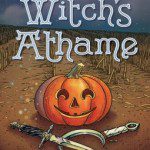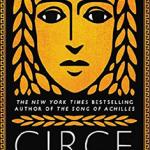 The Witch’s Athame: The Craft, Lore & Magick of Ritual Blades by Jason Mankey
The Witch’s Athame: The Craft, Lore & Magick of Ritual Blades by Jason Mankey
My rating: 4 of 5 stars
I was pleased to have received a proof copy of Jason Mankey’s new book, “The Witch’s Athame,” to review. I wanted to save the review until right around the time that the book came out, and it was released this Friday. Overall I was impressed by this book! But I’ll be honest; I just finished it because I had books that I needed to finish first, and also because the first couple of chapters are very much at a Wicca 101 level and I consequently found them difficult to get into.
This is necessary, and even important, in a book that is everything you ever wanted to know about a witch’s athame but were afraid to ask, but I’ve read a lot of 101 books by now and I found it a little slow. An experienced witch would be tempted to just skip it. I urge you not to, because hidden gems of wisdom that you may not have been aware of — such as the probable etymology of the word “athame” — are buried in the midst of the 101 material.
The introduction gives you the basics: what an athame is for, where to get one, why they are used in witchcraft. The first chapter offers “a short history” and details the origins of the athame, ritual knives in general, superstitions, why a double-edged knife and even some information on First Nations’ traditions surrounding ritual knives. It details the history of both the black handled knife (athame,) the white handled knife, and the boline. This chapter also includes some information on athame correspondences, and argues both for air and fire being its elemental association (though he clearly states his preference for fire; I disagree, which is probably my Algard roots showing.)
The second chapter deals with creating athames out of other materials, such as bone, stone or wood, and using “secret athames,” such as kitchen or Swiss Army knives. Some ideas are offered for the selection of a particular wood for its magical associations, and carving instructions are included also.
Chapter three is all about embellishments such as etching the blade and painting the hilt. There’s some really useful stuff about witch signs and magical scripts, and there are suggestions on building a scabbard if your athame didn’t come with one. Chapter four gives some simple rituals for consecrating and cleansing your athame, which I don’t think enough witchcraft books cover, so kudos for that!
Chapter five puts the athame to work in some simple Wiccan rituals, breaking down the casting of the circle, the calling of the quarters, and creating a door to the Summerlands. This is about where my personal interest started to pick up because this is good information that, again, a lot of books don’t tell you, and it was interesting to see how other traditions might interpret such things.
The following chapter talks about the boline, the white handled knife, what the difference is between the two and their connection to the Druidic sickle. I was excited to learn that originally, some paths of witchcraft had three knives, not two, because my tradition uses three knives.
For me the book became really interesting in chapter seven, which was about the use of the athame in kitchen witchery, followed by chapter eight on the sword (which, of course, is basically a big athame designed for a coven.) And I thought the book really shone in the last two chapters, which dealt with ritual, spellwork and divination using an athame (I had never considered using my athame for divination; I liked the ideas suggested and I am going to try some of them); and the use of the athame or ritual knife in traditional witchcraft (which I knew nothing about, and therefore I enjoyed reading the chapter immensely.)
If you’re a fan of Jason’s column at Patheos.com, “Raise the Horns,” (like me) you will recognize and appreciate his conversational style. Jason writes like he talks. I can visualize him giving a lecture or leading a workshop as I read his text, and that, in my view, is one of the book’s greatest strengths. It’s easy to follow, entertaining, and speckled with personal experiences and his quick wit. Jason also takes great pains to offer options in one’s practice, even though he is a Gardnerian himself (and a self-described “Hard Gard” in his own practice). I think traditional witches will appreciate his respectful treatment and solid research into their path as well.
Jason is also an excellent ritual writer, and it shows through in the rituals he includes in the book. He makes them straightforward and simple to adapt, but effective. I like the fact that he has not lost the slightly archaic witch’s art of rhyming spells (and not always in a simple ABAB or AABB pattern either!) It doesn’t seem to me like a lot of witches bother to do that these days, but it’s my personal belief that such a spell not only sticks in your mind more effectively, but also surpasses more subconscious barriers and therefore, works better than long prose spells.
I also really liked the small blurbs from other authors that were included at the ends of the chapters. Having Pagans of other traditions offer their take on the athame expanded and enhanced the effectiveness of the book. I am given to understand that this is a typical format for the Llewellyn series on the witch’s tools. If so, it works. And the interior art was absolutely amazing. It’s not only a useful book, it’s beautifully made.
I personally would have liked to see a blurb on creating an athame from scratch, but Jason explained that he felt that this was probably unnecessarily complicated, and he didn’t personally find that adapting Buckland’s instructions (from “Buckland’s Complete Book of Witchcraft”) worked well for him. He’s probably right, and certainly there are thousands of books out there on smithing if that is something you’d like to pursue; I just tend to be a little obsessive and like to craft things for myself whenever possible. But if you’re into that, you can feed that bug pretty well with Chapter Three and all the adaptations and embellishments offered. Or you can carve yourself an athame out of wood or stone, as Jason suggests.
And, as I said at the beginning, the experienced witch might find that the first couple of chapters are an exercise in patience just because of the nature of the material. Stick with it, though, and it will be rewarding.
This is a must-have for every coven bookshelf, to be given to your coveners to read just before they take their first degree so that they can fully grasp and appreciate the significance, use and history of the athame (and related bladed tools). And certainly a solitary witch who uses the traditional tools will want this book as well, probably just before she goes out to make that first athame purchase.















